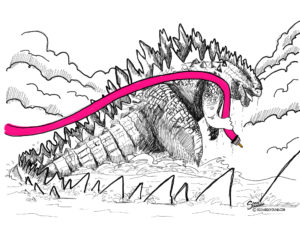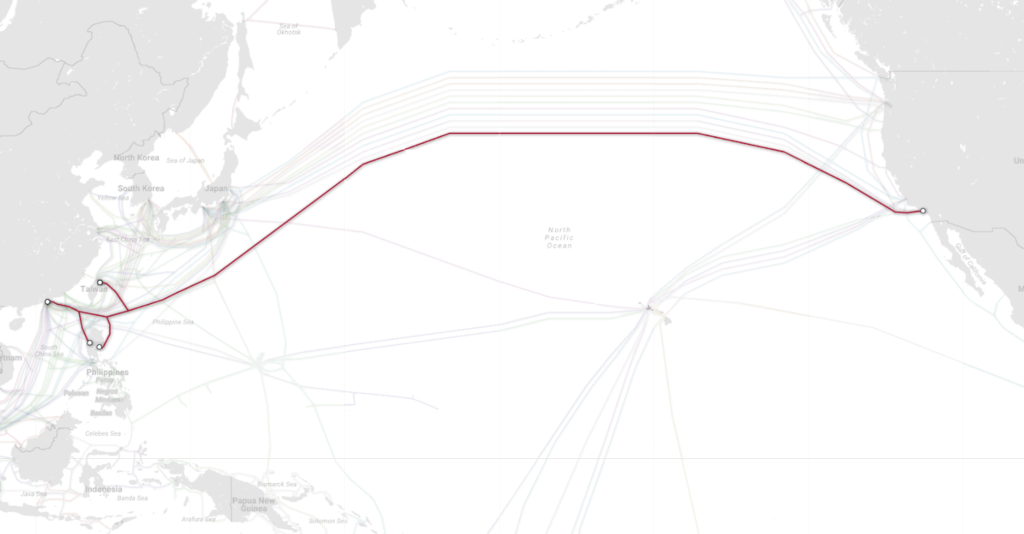 Data hungry tech giants like Google, Facebook, and Microsoft are laying their own submarine cables in order to keep up with an explosion of demand. TeleGeography, a market research firm, predicts that $9.2bn will be spent on these cable projects between 2016-2018. It is estimated that Google alone needs to double its transmission capacity every year to sustain its seamless “Cloud 3.0” computing. So far, technology giants have been able to satisfy the demand of international bandwidth usage. In 2016 bandwidth usage reached 3,544 terabits per second—double the rate of 2014.
Data hungry tech giants like Google, Facebook, and Microsoft are laying their own submarine cables in order to keep up with an explosion of demand. TeleGeography, a market research firm, predicts that $9.2bn will be spent on these cable projects between 2016-2018. It is estimated that Google alone needs to double its transmission capacity every year to sustain its seamless “Cloud 3.0” computing. So far, technology giants have been able to satisfy the demand of international bandwidth usage. In 2016 bandwidth usage reached 3,544 terabits per second—double the rate of 2014.
Now, Google and Facebook are laying a new cable from LA to Hong Kong called the Pacific Light Cable, that will connect their data centers across the ocean. It is scheduled to become operational in late 2018, and when it does, it will smash data transfer records. The cable is part of a new generation of cables that can transfer speeds up to 16 million times faster than the average home internet connection, says Microsoft. The current record of 60 terabits per second, held by the Faster Cable will be overshadowed by the Pacific Light Cable’s breakthrough speed of 120 terabits/second. Ian Chant of IEEE Spectrum talks about the technology behind these new record setting cables and the potential issues they may face.
The upcoming Los Angeles–to–Hong Kong cable, called the Pacific Light Cable Network, is spearheading that new generation. “Subsea cables represent the pinnacle of optical transmission expertise, not in terms of capacity but in terms of capacity-reach product,” says Geoff Bennett, director of solutions and technology at Sunnyvale, Calif.–based Infinera Corp., which makes terminal equipment for cables. Transoceanic cables run thousands of kilometers between landing points, so what really counts for them is data rate times distance. And judged in those terms, the Pacific Light Cable—reaching a third of the way around the world—will set a record. […]
The current transpacific record is held by the Faster Cable, made by NEC and owned by a consortium including Google and five Asian telecommunication carriers (China Mobile International, China Telecom Global, Global Transit Communications, KDDI, and Singtel). That cable stretches 9,000 km, between Oregon and Japan, with an extension to Taiwan. Its six fiber pairs each carry 100-Gb signals at 100 different wavelengths, making for a total two-way carrying capacity of 60 terabits per second.
As is standard in the industry, Faster went into operation in 2016 with only some of its 12 fibers carrying live traffic. But demand was high, so “Faster filled up real fast,” Bennett says. No wonder planners at Pacific Light Data Communication of Hong Kong had already decided to provide more bandwidth for the Pacific Light Cable. The question they faced was how to do that.
One approach is to multiply the number of paths carrying the optical signals. A cutting-edge technique to do that, still confined to the lab, is to use fibers that contain many light-guiding cores so multiple optical signals could literally run in parallel. Another avenue to high bandwidth is to make fiber cores large enough for light signals to follow several different paths through the same fiber. If the core is the right size and composition, the light carrying the different signals crisscrosses but doesn’t interact. But this tactic requires optical transmitters and receivers able to get light into and out of the core at just the right angles to keep the different signals in separate modes. And like the multicore approach, this technique is still being developed.
In principle, you can combine both strategies. Fibers that contain separate cores that can each transmit using several modes have been tested in the lab, but the process requires sophisticated equipment, and this approach is expected to be costly if and when it’s ultimately deployed in the field.
A much simpler option is to use many separate fibers, either bundled in a single cable or split among a number of them. But time-tested designs for transoceanic cables can handle only a limited number of fiber pairs with their long chains of power-hungry amplifiers.
The Pacific Light Cable Network adopted yet another strategy to increase carrying capacity: It ventured into a new optical band. That’s because the Faster Cable had gone as far as was practically possible in transmitting signals in the conventional, or C, band, which ranges in wavelength from 1,530 to 1,565 nanometers. But engineers at Pacific Light Data Communications’ cable supplier, TE SubCom, in Eatontown, N.J., opened up an additional transmission band at wavelengths between 1,570 and 1,610 nm, called the L (for long) band. Using both the C and L bands, along with other improvements, doubled the cable’s total capacity. […]
Read more here.





